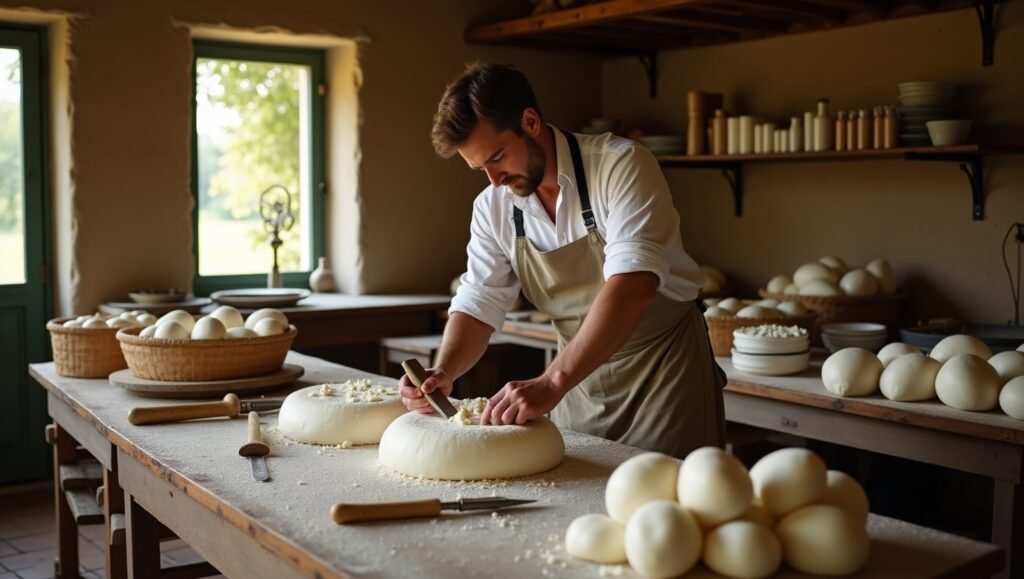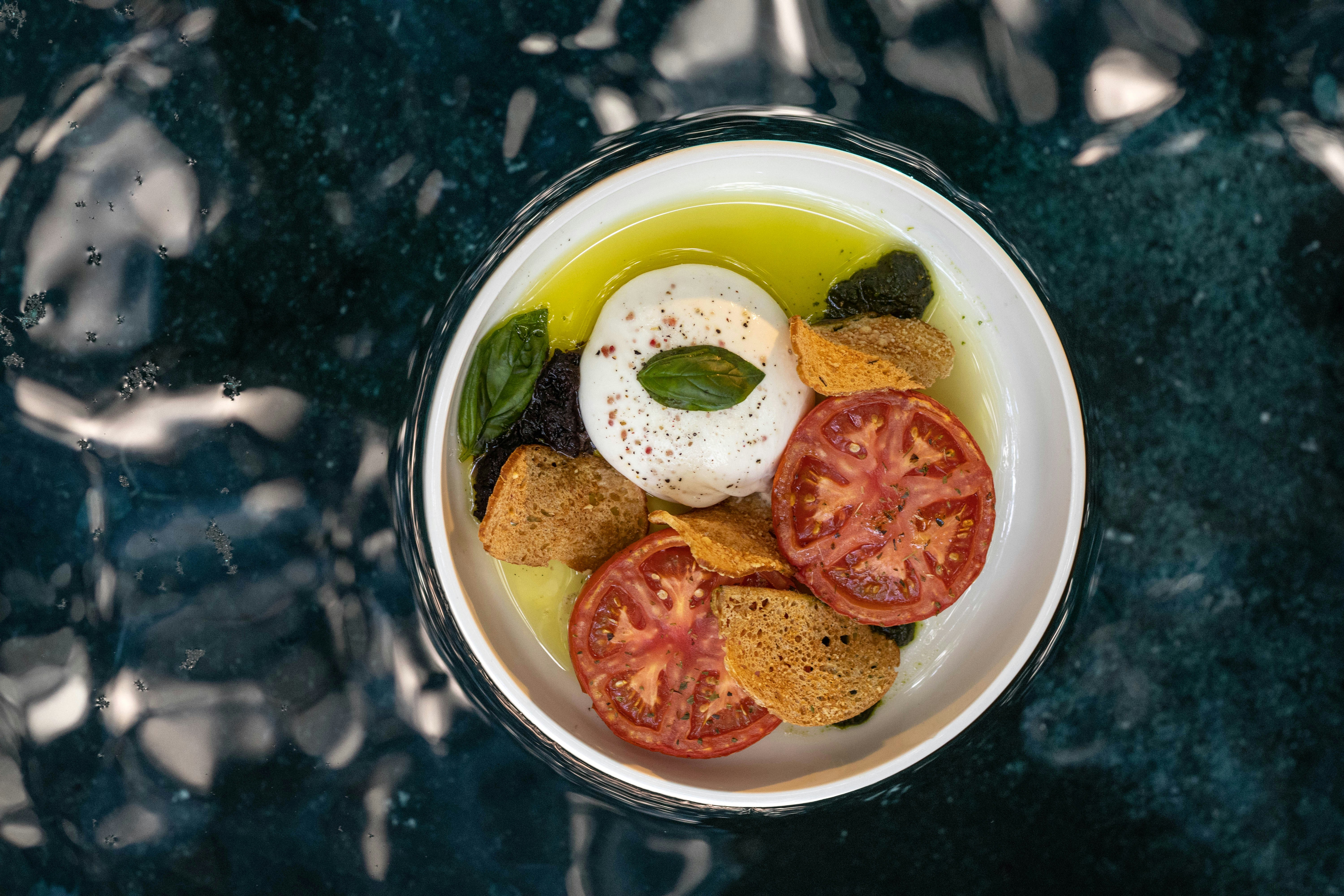The Creamy Delight of Burrata Cheese: Everything You Need to Know

Table of Contents
ToggleThe Origin of Burrata Cheese
Originating in the southern Italian region of Puglia, burrata is prized for its silky smooth texture and rich, luxurious taste. Burrata was originally created in the late 1800s as a clever way for cheesemakers to repurpose unused mozzarella remnants. Skilled cheesemakers, with creativity and resourcefulness, began encasing these remnants within a delicate pouch made of mozzarella. The result was a fresh cheese that not only minimized waste but also boasted a unique and indulgent cream-filled center.
The word ‘burrata’ comes from the Italian word ‘burro,’ meaning butter—a nod to the cheese’s rich, creamy texture and indulgent flavor. This artisanal cheese quickly gained popularity among locals due to its delightful sensory profile and versatility in various dishes. Originally produced in the town of Andria, burrata spread across Puglia and eventually captured the attention of food enthusiasts worldwide.
To maintain the traditional characteristics of burrata cheese, it is crafted using high-quality milk, primarily from water buffalo or cows. The labor-intensive process involves stretching and kneading the mozzarella to form a pouch, which is then filled with a mixture of fresh cream and leftover mozzarella bits, creating a rich, decadent center. This method not only pays homage to the cheese’s storied origins but also illustrates the dedication to artisanal production that persists in contemporary cheese-making practices.
As burrata cheese gained acclaim, its production extended beyond Puglia, yet many connoisseurs continue to regard the authentic varieties from this region as the benchmark. The combination of local milk, traditional techniques, and a deep-rooted connection to Italian culture has sealed burrata’s status as a cherished delicacy, showcasing how humble beginnings can lead to extraordinary culinary experiences.
The Art of Making Burrata Cheese
Burrata is a refined and elegant cheese that highlights the artistry and precision of classic cheese-making traditions. To fully appreciate this creamy delight, one must understand the intricate process involved in its creation. The primary ingredients used in making burrata are fresh mozzarella and cream. The quality of these ingredients significantly affects the final product’s taste and texture.
The cheese-making process begins with the curd formation. Fresh milk, typically cow’s milk, is heated and combined with rennet and starter cultures, which initiate the coagulation process. As the milk curds form, they are cut into small pieces to facilitate whey expulsion. The curds are gently heated and stirred to help achieve the smooth, stretchy texture characteristic of fresh burrata. This critical stage determines the elasticity and stretchiness of the mozzarella base.
Once the curds have reached the appropriate consistency, they undergo a process known as pasta filata, where they are kneaded and stretched This process not only refines the cheese’s consistency but also readies it for molding into its signature form. The cheese maker skillfully shapes the mozzarella into a pouch that will later be filled with a mixture of cream and leftover curds. This filling is what gives burrata its signature creamy heart and rich flavor profile.
The final touch involves sealing the pouch, carefully ensuring that the creamy filling is encased within the mozzarella shell. This requires not only precision but also an understanding of the cheese’s elasticity to avoid any breakage. Creating high-quality burrata is indeed an artisanal practice that requires considerable expertise, as the slightest mistake may compromise the cheese’s texture and taste. Perfecting the craft of burrata-making is a heartfelt endeavor that honors the time-honored legacy of Italian cheesemaking.
Nutritional Value of Burrata Cheese
Burrata cheese is renowned for its rich, creamy texture and distinctive flavor, but it also boasts an impressive nutritional profile that makes it a valuable addition to a balanced diet. A standard 100-gram portion of burrata contains close to 300 calories, highlighting its decadently creamy and indulgent profile. This caloric content primarily comes from fat, which can range between 24 to 30 grams, depending on the specific brand and milk used for production.
The fat content in burrata cheese is relatively high, composed mainly of saturated fats. However, it is essential to note that these fats can contribute to a feeling of fullness and satisfaction, potentially reducing overall calorie intake when consumed in moderation. Furthermore, the creamy center of burrata is made from fresh mozzarella and cream, providing a unique gastronomic experience while also being a source of important nutrients.
When examining its protein content, burrata offers about 10 to 12 grams per serving. This protein is vital for muscle repair and growth and supports various bodily functions. Comparatively, burrata contains less protein than firmer cheeses, like Parmesan or Cheddar, which can have over 25 grams of protein per 100 grams. Thus, while burrata may not be the highest protein cheese available, it compensates with its unique flavor and texture.
Burrata cheese also presents a variety of vitamins and minerals, including calcium, which is crucial for bone health, and vitamins A and B12, supporting vision and nerve function, respectively. When included in a balanced diet, burrata can elevate dishes while providing nutrients that contribute to overall well-being. Consuming it alongside fresh vegetables or whole grains can enhance its health benefits while satisfying culinary cravings.
Health Benefits of Burrata Cheese
Burrata cheese is not only a culinary delight but also offers several health benefits that make it a valuable addition to a balanced diet. A key health advantage of burrata lies in its high calcium levels—an essential mineral that supports strong bones and teeth. Including calcium-rich foods like burrata in your diet can promote better bone health over time. With age, maintaining sufficient calcium levels becomes essential to help ward off bone-related issues such as osteoporosis.
Alongside its calcium content, burrata also provides a solid dose of protein, adding to its nutritional value. Protein plays a crucial role in tissue growth and repair, supports enzyme production, and helps maintain a healthy immune system. Including protein-rich foods in your diet can help support muscle mass and promote overall health. The protein content in burrata can be particularly beneficial for individuals who are physically active or those looking to manage their weight, as it helps to enhance feelings of fullness and satisfaction after meals.
Another noteworthy aspect of burrata cheese is its potential role in weight management. When consumed in moderation, dairy products like burrata can help individuals feel satiated, potentially leading to reduced overall caloric intake. Nevertheless, moderation is key, as burrata’s high fat content can quickly add up if portion sizes aren’t kept in check. For those with lactose intolerance, burrata may be easier to digest than other dairy products, depending on individual tolerance levels. Though some people with lactose intolerance can enjoy small portions of soft cheeses like burrata without adverse effects, it is advisable to consult a healthcare professional if unsure.
While burrata cheese provides several health benefits, it is crucial to consume it as part of a varied and balanced diet. Integrating burrata into meals can enhance flavor and texture while contributing to your overall nutritional goals.
Culinary Uses of Burrata Cheese
Burrata cheese, renowned for its creamy interior and delicate outer shell, serves numerous culinary applications that highlight its unique flavors and textures. Originating from Italy, this artisanal cheese has become a staple in kitchens around the world. Its versatility allows it to be incorporated into a variety of dishes, ranging from traditional Italian recipes to innovative modern cuisine.
Frequently featured in classic antipasto spreads, burrata lends its rich creaminess to elevate the overall flavor and texture of the platter. Served alongside cured meats, olives, and crusty bread, burrata makes for an indulgent appetizer that appeals to a range of palates. It also pairs beautifully with heirloom tomatoes, enhanced by a drizzle of premium olive oil, a pinch of sea salt, and fresh basil leaves for a vibrant, flavorful bite. This preparations not only accentuates burrata’s creamy texture but also celebrates the flavors of summer produce.
In creative culinary applications, burrata can be used as a sumptuous topping for pizzas or flatbreads. When placed on a hot pizza right after baking, burrata melts slightly, creating a rich, gooey texture that contrasts beautifully with crisp crust and savory toppings. Furthermore, it can brighten up pasta dishes; when tossed with fresh vegetables and a light sauce, burrata adds an element of luxury, ensuring a satisfying mouthfeel.
In addition to classic pairings, burrata pairs beautifully with fruits like figs and peaches, offering a harmonious blend of sweetness and savory richness. Incorporating burrata into salads with arugula, nuts, and vinaigrette can elevate the dish with its creamy richness, while enhancing the overall texture and flavor profile. Furthermore, burrata works well in sophisticated sauces, lending its creaminess to enhance the meal experience.
Ultimately, the culinary possibilities offered by burrata cheese are virtually limitless, encouraging both chefs and home cooks to explore its potential in an array of dishes, thus celebrating the delightful creaminess that this cheese brings to every meal.
Storing Burrata Cheese Properly
To maintain the freshness and unique flavor of burrata cheese, proper storage is essential. Burrata, known for its rich, creamy interior sealed within a delicate mozzarella shell, requires specific care to preserve its delightful characteristics. First and foremost, refrigeration is crucial. For optimal freshness, burrata should be kept in your refrigerator’s cheese drawer at a temperature between 34°F and 40°F (1°C to 4°C). This temperature range helps to slow down spoilage and retain its creamy texture.
When it comes to packaging, it is advisable to keep burrata in its original packaging if possible. To preserve its freshness, transfer burrata to an airtight container if the original seal is broken or the packaging has been opened. You can add a small amount of its liquid brine or whey to the container, which helps to keep the cheese moist and flavorful. If you are transferring it to another container, ensure it is made of glass or plastic that is safe for food storage.
Once opened, burrata cheese generally stays fresh for 5 to 7 days. When unopened and properly refrigerated, it may remain good for up to two weeks beyond the labeled ‘best by’ date. It’s important to play attention to signs of spoilage; burrata that has gone bad may exhibit a sour smell, an off-colored appearance, or a dried-out texture. Consuming spoiled burrata can negatively impact both flavor and health.
To prolong freshness, consume burrata within its optimal timeframe after purchase and avoid leaving it out at room temperature for extended periods. By adhering to these best practices for storing burrata cheese, you can enjoy its delicious creamy delight to its fullest potential.
Understanding the Differences Between Burrata, Mozzarella, and Ricotta
Burrata, mozzarella, and ricotta are all beloved cheeses that hail from the rich culinary tradition of Italy, yet each boasts distinct characteristics that set them apart. Burrata, in particular, often captivates the palate with its unique blend of creamy and chewy textures. Mozzarella is admired for its stretchy texture, but burrata elevates the experience with a soft outer shell that hides a luscious, creamy core. The texture of burrata is one of its most defining attributes, with the smooth, soft curd creating a delightful contrast to the firmer mozzarella.
When it comes to flavor, burrata outshines both mozzarella and ricotta with its exceptionally creamy and luxurious taste. While mozzarella presents a mild, milky taste with a slightly salty note, burrata’s flavor profile is enriched by the buttery cream within, often described as indulgent and luxurious. On the other hand, ricotta offers a sweet, slightly grainy taste that emerges from its production process, which involves cooking whey from other cheeses. This results in a light cheese that is notably less rich than burrata but is perfect for mixing into dishes or crafting sweet desserts.
When it comes to production methods, burrata is made by stretching mozzarella curds until they are pliable, which is then filled with cream and pieces of mozzarella. In contrast, mozzarella is formed from whole milk curds that are heated and kneaded. Ricotta, however, is created by reheating whey—leftover liquid from the cheese-making process—which ensures it has a distinct, less structured form. Each cheese serves diverse culinary purposes, with burrata often served fresh in salads or atop pizzas, mozzarella acting as an excellent melting cheese, and ricotta providing an ideal base for sweet or savory dishes almost anywhere. Burrata’s unique characteristics truly set it apart from both mozzarella and ricotta, making it a standout choice in the cheese family.
Popular Brands and Varieties of Burrata Cheese
Loved by cheese enthusiasts around the globe, burrata has risen in popularity for its luxurious creamy core wrapped in a tender outer shell. Several well-known brands and artisanal producers have emerged, each offering unique takes on this beloved cheese. Among the most recognized brands are Calabro, known for its authentic Italian craftsmanship, and BelGioioso, which prides itself on producing high-quality, fresh burrata with a rich flavor profile. These brands provide consumers with consistent quality, catering to both culinary professionals and home cooks alike.
Regional differences also play a significant role in the variety of burrata available. For instance, Southern Italy is renowned for its traditional burrata, which often features a distinctively rich and buttery taste, reflecting the high-quality local milk used in its production. On the other hand, some modern American producers, such as Di Stefano Cheese and Crescenza, have started experimenting with flavors and infusions, offering varieties that incorporate herbs, spices, or even truffles. These innovative creations not only enhance the sensory experience but also showcase the versatility of burrata cheese.
The texture of burrata can also vary significantly among producers. Some burrata varieties are prized for their smooth, velvety centers, while others offer a slightly firmer texture, lending themselves to a wider range of culinary uses. This diversity invites chefs and food enthusiasts alike to explore various brands and discover their personal favorites. Whether used in salads, paired with ripe tomatoes and basil, or featured on a charcuterie board, the exploration of these distinct burrata varieties can lead to delightful culinary experiences. By understanding the differences in taste, texture, and regional influences, cheese lovers can truly appreciate the creamy delight that burrata cheese offers across its many forms.
Conclusion: Embracing Burrata in Your Kitchen
In the journey of culinary exploration, the exquisite nature of burrata cheese provides numerous opportunities to elevate both simple and sophisticated dishes. Through the discussion of its unique texture, flavor profile, and versatility, it is evident that burrata is a delightful addition to any kitchen. Its creamy, fresh interior pairs beautifully with a variety of ingredients, allowing for an array of exciting culinary experiments.
The melting richness of burrata can transform a basic salad into a gourmet experience. When combined with ripe tomatoes and basil, the three create a quintessential Caprese salad that showcases the cheese’s qualities. Additionally, burrata complements charcuterie boards magnificently, offering a contrasting texture to cured meats and enhancing the overall flavor palette. As explored, its application extends beyond appetizers; it can also play a significant role in main dishes, often featured on pizza, pasta, or as a sumptuous topping on a warm risotto.
Moreover, burrata cheese invites cooks to incorporate seasonal ingredients, fostering creativity and experimentation in the kitchen. Whether drizzled with olive oil, sprinkled with sea salt, or melded with fruits, the cheese’s adaptable nature makes it a favorite among both amateur cooks and seasoned chefs. The pleasure derived from burrata is not solely in its taste but also in its aesthetic appeal, with its elegant presentation capable of impressing any guest.
As you venture into your culinary endeavors, we encourage you to embrace the creamy delight of burrata cheese. Allow it to inspire your dishes, provoke your creativity, and bring joy to your dining experiences. With its rich flavor and versatility, burrata is indeed a cheese worth celebrating in your kitchen.


Pingback: Chicken Alfredo Recipe – Creamy, Homemade & Full of Flavor
Pingback: The Best Mexican Street Corn Recipe: 5 Easy Steps for
Pingback: 5 Proven Steps: How to Steam Broccoli for Crisp, Healthy